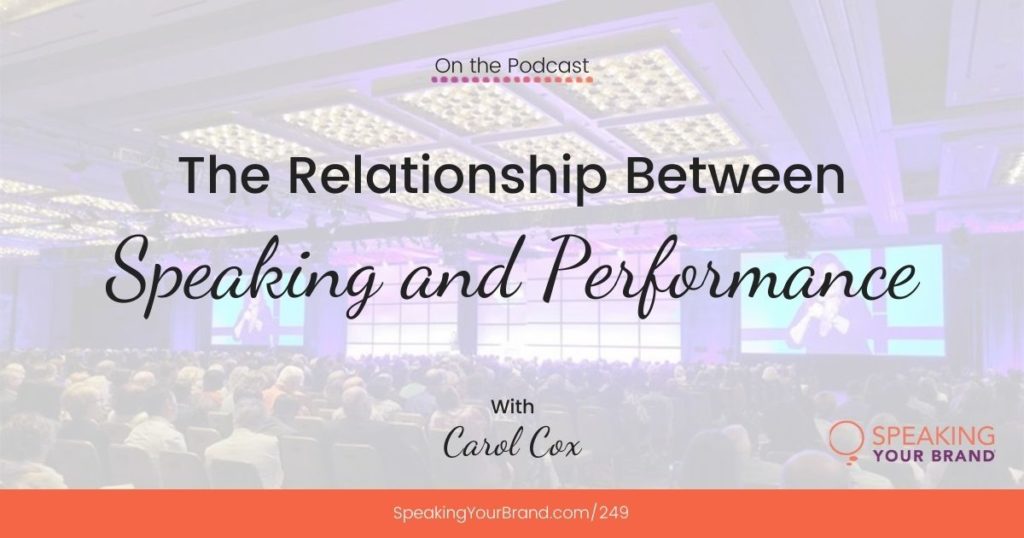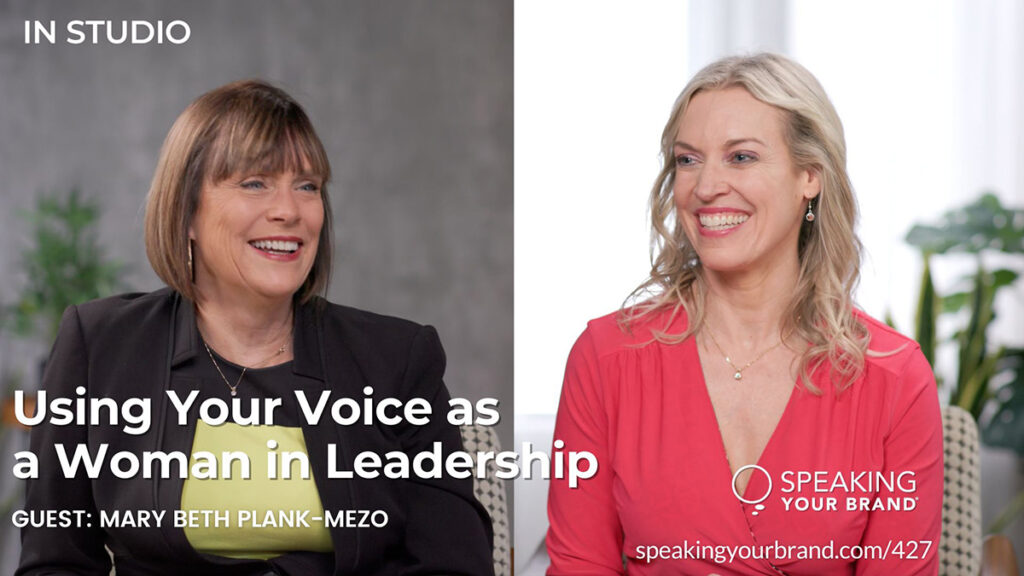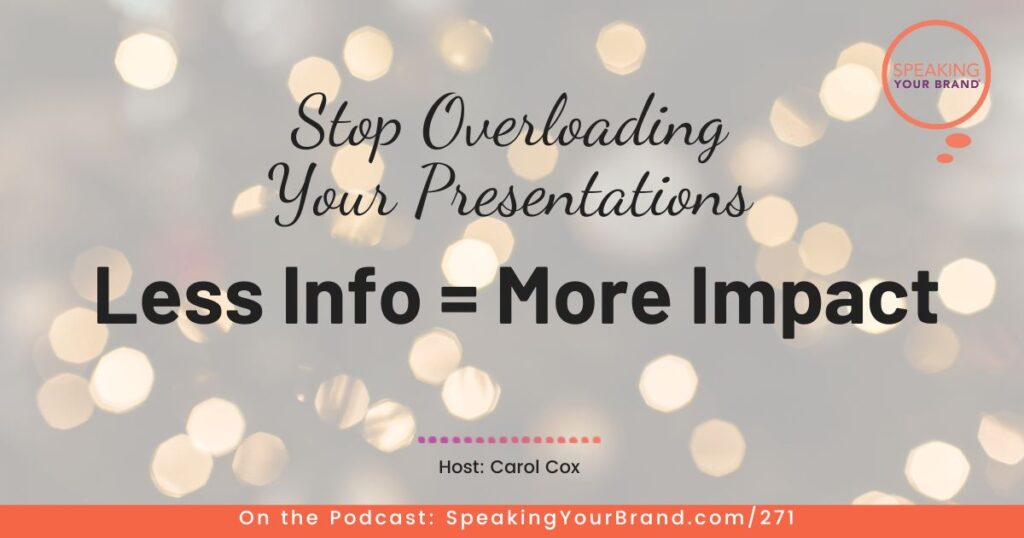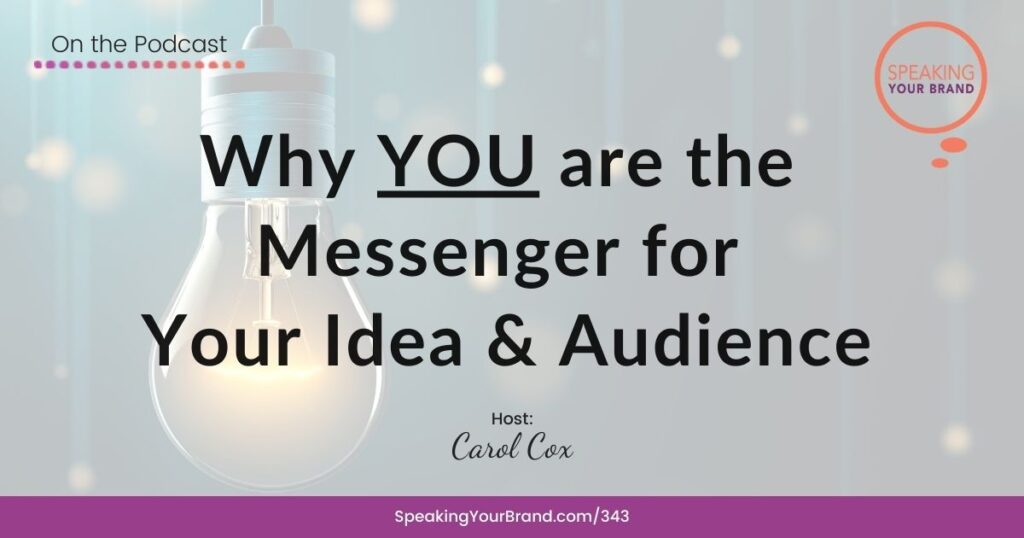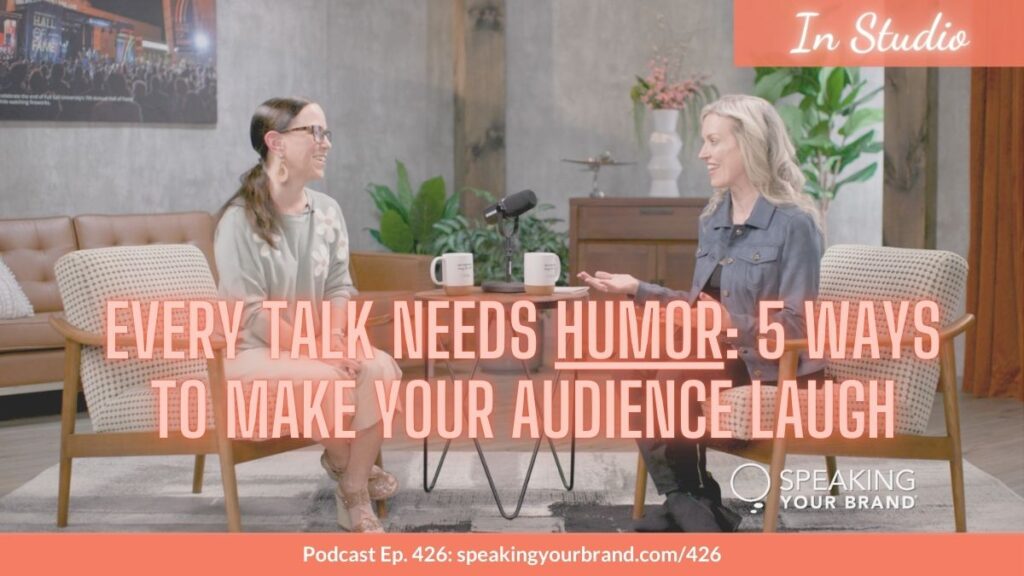249-SYB-Speaking-and-Performing.mp3: this mp3 audio file was automatically transcribed by Sonix with the best speech-to-text algorithms. This transcript may contain errors.
Carol Cox:
What's the relationship between speaking and performance and how can you incorporate performance elements into your presentations? Listen in to this episode of The Speaking Your Brand podcast. More and more women are making an impact by starting businesses running for office and speaking up for what matters. With my background as a TV political analyst, entrepreneur and speaker, I interview and coach purpose driven women to shape their brands, grow their companies and become recognized as influencers in their field. This is speaking your brand, your place to learn how to persuasively communicate your message to your audience.
Welcome to the Speaking Your Brand podcast. I'm your host, Carol Cox. I hope that you are doing well. I cannot believe it is already November of 2021. 2020. Felt like the year that was never going to end. And now 2021, I don't know. I feel like it's been a blink of an eye since January, February of this year, and now all of a sudden we're in November. I can't believe we're wrapping up this year. And I think part of it is because we are obviously seeing kind of not the end of COVID, but things returning back, especially in person conferences and events, which is what we've been focusing on here on the podcast for the past about six weeks, we've been doing a series on in-person speaking, and today I'm going to talk about the relationship between speaking and performance.
If you're new to the podcast, welcome. I'm so glad that you're here as speaking your brand. Our mission is to help more women entrepreneurs break out of the expert trap and become thought leaders and sought after paid speakers.
And so this is why we're doing this series around in-person speaking, because the most sought after and the most highly paid speakers are speakers who do so in person. And obviously for the past 18 months or so, we have been stuck on Zoom and stuck virtually. But we really need to continue to develop our skills and put ourselves out there as in-person conferences and events return. And at the same time, I know we're going to continue to do a lot of virtual presentations going forward as well.
Now, this episode about the relationship between speaking and performance was prompted by our Thought Leader Academy Call that we had about a month ago. The first call for this current group that's going through the academy. And in that first call we do introductions so that each woman can introduce themselves what they do in their business. And we also ask them to share what they like to do when they were young, what kind of activities, hobbies, things like that did they like to do? And no surprise, a lot of the women like to play teacher and because as speakers and especially as speakers for our businesses, we like to teach, we like to train. So that wasn't a surprise. I was surprised that a number of women said they'd like to climb trees when they were young. And I like to climb trees too. I don't know about you, but that was so much fun and I feel like, I don't know, probably too old to go climb a tree right now, but it seems it was just it was so fun to do. So I remember it as a kid, like running around with my sister. We grew up in South Florida and like, just running around and not in like not in deep canals, but like in the canals that were dried up during the winter and then climbing trees. So much fun. And then the other thing that I found for nearly all of the women and there's 13 women in the academy right now, nearly all of them, is that they loved performing when they were young. So whether it was in school plays, singing, dancing, there was some type of performance aspect to what they enjoy doing, and that was the same for me. I love to be in school plays. I'd love to give presentations in front of the class, no surprise. And I also was in dance. I did ballet and jazz when I was in high school, and at the end of this episode, I'll share an embarrassing moment from a high school performance that I was in. But here's the thing about the relationship between speaking and performance. Once we start speaking for our business, we're doing it for brand awareness, we're doing it for lead generation, and we also do it to get paid.
Carol Cox:
We oftentimes don't see the connection between speaking and performing, and we miss out on bringing performance elements into our presentations and into our speeches. Now, you don't need to sing and dance in your presentations unless of course, you want to, which I highly encourage. If you do now, I cannot sing at all, so I will not be singing. But I could do some dance moves. But there are things that you can do to create a more immersive and memorable experience for your audience, which is what we're going to talk about today. Now let's get on with the show. What do we like about watching performances? And performances can be plays, musicals, concerts, dance, opera, movies and so on. And I think about the performances that I've attended in the audience there. Here in Orlando where I live, there's the Orlando Shakespeare Theater, and they put on plays every season. Not only Shakespeare, of course, I love seeing the Shakespeare plays, but they put on Jane Austen plays, they put on contemporary plays. I remember a few years ago they did a play around Dracula and that was so much fun. So definitely plays musicals. Of course, you know, I love Hamilton, the musical. When I was in New York City a couple of years ago, I saw Moulin Rouge the Musical, which was just an extraordinary production the costumes, the lighting, of course, the music, the the actors, the whole thing was so immersive.
Carol Cox:
So that's one reason why I cannot wait to get. To New York City just to go to to see some more musicals. I also love going to concerts. I think of ones that I've seen just in the past few years, Florence and The Machine. I didn't really know much about her and her music, but I happened to go to a concert with some friends back in. I think this was 2019, and even though we were high up in the arena because we had gotten tickets really late, we were really high up and you can kind of see the band and Florence on the stage, but she just filled up the entire arena. She filled up the entire stage. And then I also love to see Sting. I've seen him, I think three or four times over the past 20 plus years, and I can't wait. I definitely want to go see him again. The Chainsmokers, which is not probably a concert you would think that I would go to. But we went and it was so much fun and it was truly a production and immersive experience. Not only did they have, of course, the singers and the band, but then at some point towards the end, they actually had a motorcycles going around like those cages where they go around it around 360 degrees.
Carol Cox:
And then they had the drummer up on a platform with fire coming out of his drumsticks. I mean, talk about a production. And then my husband and I went to see Guns and Roses also back in 2019, and I've loved Guns and Roses since they came out in 1987. I think the Welcome to the Jungle came out. And of course, my husband is absolutely been a huge fan of them since then as well. And so when we saw that they were coming into concert nearby, we grabbed tickets and we went. And did you know that Axl Rose is quite the liberal like I you wouldn't think that, but he really is if you follow his Twitter account, especially back before the 2020 election, you would see that. And, you know, obviously they're older, right? All the all these musicians are much older now. But, you know, he moved around the stage and he sang and he performed. And at some point, one of the songs, I forget what the name of the song was, but they had like a video montage going on the screen and they had quotes from Martin Luther King and very a very progressive message. And we were my husband and I were just like, Oh, wow, I can't believe this because I don't think the rest of the audience where we were was quite expecting that. And then think about performances like dance and opera.
Carol Cox:
When I was growing up in South Florida, we would see the Miami City Ballet and they were a great ballet company. And again, just like the commitment to their craft, the commitment to their performance, and then of course, movies as well. Some of my favorite movies that I thought of for this episode would be like Bohemian Rhapsody, Cruella. I love Interstellar. I've seen that many, many times. So think about the different performances that you have attended over the years plays, musicals, concerts, dance opera, movies that you've seen. What did you like about them? What What captivated you about them? What makes you want to go see performances? And so here are some of the things that I have thought of. First of all, performances are very immersive. They really bring the audience in and for that hour and a half or that 2 hours, you really are in that present moment. I also love that your phones are away. You're not you're not kind of looking at social media, you're not looking at text messages. Hopefully you're not thinking about email and work and you're really kind of provide you with this cocoon of an immersive experience, but it's also expansive. At the same time, it's both immersive, kind of insular and expansive at the same time, which is what I love and so expansive in the sense that it helps you as the audience member. Think of other things, like think of what's possible, Think of bigger things as you're immersed in this experience.
Carol Cox:
And I think this kind of tension between being immersive and expanses happens because performances are very sensory experience. They incorporate so many different things sights, sounds, they could incorporate smells, they can incorporate tactile things. Even though you as an audience member may not be touching things, The the people on the stages are doing things physically with their bodies and with props and costumes. So it's very much a sensory experience. You have the lights, you oftentimes have music, and of course if it's a play, you have dialogue and so you really are create the performance is creating a little micro world, kind of a little world for you as the audience member to come in and enjoy for that two hour time period. Performances also have a narrative arc, and I talk a lot about on this podcast about story structure and narrative arc, because that's really how as human beings, we have learned over millennia and over tens of thousands of years to process. And remember, information is through storytelling and narrative arc is the way that we do that by having a beginning, middle and an end, by taking our audience on a journey from creating the situation, the tension that's going on with the main characters to what are the situations that those characters get into, what is it that they want for themselves, both externally and internally, and then the resolution of that.
Carol Cox:
So taking your audience on a narrative arc before. Performances also tap into our emotions. They allow us to feel emotions that we may not otherwise allow ourselves to feel. And so it can be emotions like especially like sadness. I don't know about you, but if I'm watching a play or a TV show or a movie and a character starts crying, I will cry as well. Or I'll start tearing up. And that's because we have mirror neurons as humans. And so we have evolved to do that because we want to empathize. We want to have that connection with that other person. So even though that other person is not, quote unquote, real, even though that other person may be on a screen or up on a stage, we can still feel those emotions that they're feeling and allows us to feel them. And that's ultimately what it's about to be a human being is to have these emotions and to feel so sadness, obviously happiness, laughter through humor. We can also feel frustration. We can feel anger like if we're watching a play or a movie and something's going on and maybe we feel anger. So allows us to channel these different emotions, performances also show us how the actors, the musicians, really the dancers really commit to what they're doing. They commit to their role, they commit to their performance. They go all in. Can you imagine going to a play or a musical or a concert or a dance? And the people on the stage are not committed.
Carol Cox:
They're just like, I'm here. Maybe I'll remember my lines, maybe I'll dance really well, maybe I'll sing this song, maybe I won't. No, of course not. I mean, if they're at that stage, if they're on that stage, they are professionals. They've made it that far because they've committed to their performance, they've committed to their role, they've committed to who they are and how they want to show up for their audience. And that's what I want you to think about for yourself as well. There was a great article in The New York Times about a month or so ago by Adam Grant, the organizational psychologist, and he talked about what we've been missing from the pandemic is this synchronicity. So as an audience, when we're together in a performance, especially live performances, but this can happen in movie theaters, too, when we're laughing together, when we're clapping together. And of course, if you're going out to dances and yourself or you're actually dancing, there's this element of synchronicity that's really important to us as human beings. And here's what Adam Grant says in the article. There's this term called Collective Effervescence, and as he explains in the article, it's a concept coined in the early 20th century by sociologist Émile Durkheim to describe the sense of energy and harmony people feel when they come together in a group around a shared purpose.
Carol Cox:
Collective effervescence is the synchrony you feel when you slide into rhythm with strangers on a dance floor, colleagues in a brainstorming session, teammates on a sports field and so on. And so really, I feel like as when we're in audiences, in performances, we are tapping into this idea of collective effervescence and synchronicity, which is so important for us. It really lends itself to understanding ourselves better, understanding each other better, and this sense of connection that we have not only with the people on the stage, but with each other in the audience. So now let's get to some of the practical elements here. What can you do as a speaker, especially as a business speaker? So you're doing presentations for your business. Perhaps you're doing keynote talks, maybe you want to do a TEDx talk. How can you incorporate performance aspects into your presentations? And before I do that, let me just say like, why would you want to do these things in the first place? Well, here are three things that I have written down as far as why you would want to do these things. Number one, to develop your skills. You're probably like me in the sense that you like to learn new things. You like to try new things, you like to develop your skills. So this is one way to do this is to add these performance aspects to develop your speaking skills.
Carol Cox:
The second reason is to improve the experience for your audience so that they enjoy it more and it's more memorable for them. And if it is, and they're learning more, if you can provide an experience for your audience, they're going to have even more valuable learnings and takeaways. And the third reason is that when you incorporate performance aspects into your speaking, you're going to attract better speaking opportunities. Word's going to get around what a fantastic speaker you are, so you'll get those higher profile speaking opportunities, including paid ones. So now let's talk about what you can do as a speaker to incorporate these performance aspects. The first thing is definitely make sure that your presentation, your speech, has a narrative arc. This applies whether you're doing a practical business presentation or you're doing a keynote story driven talk. You want to have a clear beginning, middle and end, and you want to take your audience on a journey. This is what we teach in our Thought Leader Academy, and when we work with our clients in a VIP day, either in the Thought Leader Academy or separately, when we work together on their signature talk, we use our speaking your brand framework that I've created, which is three X story structure with this narrative arc built in. And the reason. This narrative arc is so powerful is because in the beginning you're building tension and you're building suspense. And as you're doing so, you're foreshadowing things that are going to come.
Carol Cox:
You're setting up the goal and the problem and the obstacles and the situation and what your audience wants. And you're building this tension, then the audience is waiting for that tension to be released. And that's what you do then during your presentation. The other thing to definitely incorporate is emotion and vulnerability. Audiences are not expecting perfection from you, perfection from your speaking, perfection from your story's perfection from who you are. They want to see that realness, that rawness, that vulnerability. And they also want to, as I mentioned before, tap into their emotions to allow us to feel things when we're listening to you. So whether those feelings are happiness, laughter, sadness, anger, outrage, frustration, whatever it happens to be, of course you want to balance those emotions and have a good blend of them throughout your presentation and your speech. You can also incorporate multimedia elements. These could be music video clips, audio clips, sound effects. I've done all of those during my presentations and they really do add another layer to your talk, providing that sensory experience. You can use props, you can use costumes, you can have the audience actually move around. So stand up. They can do it again. You don't have to do like full on dance numbers, but you can definitely get the audience to move and dance a little bit. You don't have to sing, but you can put some music on and get and have everyone sing together so that your voice doesn't stand out, which would be my option there.
Carol Cox:
So think about how you can add these multimedia and sensory elements to your presentations and your speeches. I mentioned commitment earlier and how the pros really they commit to their performance, they commit to their role. So I want you to do the same thing when you're speaking. Use the stage, use the entire environment that you have. Use your body, use your voice. I talked in an episode about a month or so ago that behind the scenes of a recent keynote that I gave in person and how I use my voice in different ways to convey different emotion and how that really resonated with the audience. So I mentioned about earlier on an embarrassing story that I was going to share from a high school performance that I was in. So I mentioned that I was did ballet and jazz dancing, and so we had a recital. One year is probably 15 or 16 years old, and it was a group of us, a group of dancers who were in my class. And we had obviously practiced the dance that we were going to do for the performance. And so I was kind of in the center of the group and we were at our rehearsal. This was probably about a week before the actual live performance. So we were rehearsing in the auditorium where we were going to do the actual performance.
Carol Cox:
So it was a full on dress rehearsal with everyone who was going to be in the performance. So our time came on. So the music comes on. Obviously I'm dancing and I'm in my costume and all of a sudden I do a turn and I feel the snaps around my neck that held up the costume totally come off and my entire office is like a leotard type of thing, totally comes off and I'm not wearing a bra or anything because I didn't need to with the leotard, but so the whole thing came off. Now, luckily there weren't many people in the audience, maybe a couple of parents. This was also way before the era of camera phones and really not even camcorders back then. So thank goodness. But here's the lesson that I took from that. I am so glad that happened, because then when it came for the live performance, you know what I did? I put safety pins back at the top of my neck where the snaps were. So I had the snaps, but then I had the backup of the safety pins. And if that hadn't happened during the practice, who knows if it could have happened during the actual live performance. So this is the importance of practice. So whatever you're going to do for your presentations and your speeches, if you want to incorporate some of these performance aspects like multimedia and building tension and vulnerability, using the stage, using your body and your voice, costumes, props and so on, definitely practice ahead of time.
Carol Cox:
I hope you enjoyed this episode and it got you thinking about performances that you enjoy attending, why you enjoy it, and how you can incorporate some of those aspects into your own speaking. I would love for you to share this episode on social media. I mostly hang out on LinkedIn and Instagram and you can find my profiles in the show notes for this episode, which is at speaking your brand dot com slash 249. Again that speaking your brand dot com slash to four nine the episode number. So share this episode on social tag me and I would love to know if you also love performing when you were young so when you were in elementary school, middle school high school, did you act in plays? Did you sing? Did you dance? Did you play an instrument as far as recitals, anything like that? I would love to know, if you will. Like to work with us to develop your speaking skills and to elevate yourself into a thought leader. I would love for you to apply for our Thought Leader Academy. You can get all of the details and submit the application form by going to speaking your brand dot com slash academy. Again, that speaking your brand dot com slash academy. Until next time. Thanks for listening.
Sonix has many features that you’d love including advanced search, powerful integrations and APIs, automated subtitles, automated translation, and easily transcribe your Zoom meetings. Try Sonix for free today.

